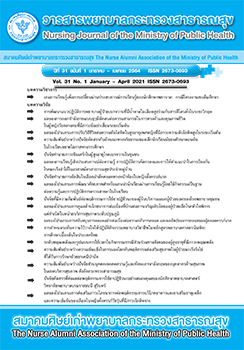The Development of Clinical Nursing Practice Guideline for Patients with Diabetic Ketoacidosis in Critical Phase
Main Article Content
Abstract
This research and development study aimed to develop clinical nursing practice guidelines (CNPG) for patients with diabetic ketoacidosis in the critical phase and to evaluate the results of applying the developed CNPG. The study was conducted in a medical ward, Rajavithi Hospital, during January 2019-October 2020, which consisted of 4 phases, as follows: 1) situation analysis, 2) CNPG development, 3) implementation of CNPG, and 4) the CNPG outcome evaluation. The development process was conducted based on the Deming cycle and the concept of CNPG development of the National Health and Medical Research Council; Australia. A purposive sampling method was used to select samples, which were 1) 40 registered nurses, and 2) 70 DKA patients composed of 35 allocated to a control group and 35 to an experimental group. The data were analyzed using frequency, percentage, mean, standard deviation and paired t-test statistics. The study found that CNPG for patients with diabetic ketoacidosis was divided into 4 phases: 1) critical phase, 2) post-critical phase, 3) discharge planning phase, and 4) return for follow-up examination phase. The CNPG was then evaluated. It was found that 1) the duration of time of the patients were out of ketone retention decreased from 28.23 hours to 16.18 hours, 2) none was re-admitted to the hospital within 28 days, 3) glycemic control increased from 11.4% to 35.1%, 4) the mean behavioral score of glycemic control of the experimental group after using CNPG was significantly higher than before using the CNPG for each item and overall at the 0.05 level, and 5) the majority of registered nurses (86.25%) reported a high score on the application of the CNPG. However; nursing practice based on this CNPG should be continuously monitor using PDCA process to cover all categories and all issues.
Article Details
บทความและรายงานวิจัยในวารสารพยาบาลกระทรวงสาธารณสุข เป็นความคิดเห็นของ ผู้เขียน มิใช่ของคณะผู้จัดทำ และมิใช่ความรับผิดชอบของสมาคมศิษย์เก่าพยาบาลกระทรวงสาธารณสุข ซึ่งสามารถนำไปอ้างอิงได้
References
2. American Diabetes Association. Standards of medical care in diabetes-2016. Diabetes Care 2016;32(1):S13-S99.
3. World Health Organization. The top 10 causes of death. [internet]2020[cited 2021 Jan 17]; 1-9. Available from:http//www.who.int/news-room/fact-sheets/detail/the-top-10-causes-of-death.
4. Division of Non Communicable Diseases. Statistics of death/illness of non-communicable diseases. 2020 [cited2021 Jan 17] Available from http://www.thaincd.com/2016/mission3. (in Thai)
5. Kitabchi AE, Umpierrez GE, Murphy MB, Barret EJ, Kreisberg RA, Malone JI, et al. Hyperglycemic crises in diabetes. Diabetes Care 2004;27(1):94-102.
6. Thewjitcharoen Y, Plianpan P, Chotjirat A, Nakasatien S, Chotwanvirat P, Wanothayaroj E, et al. Clinical characteristics and outcomes of care in adult patients with diabetic ketoacidosis: a retrospective study from a tertiary diabetes center in Thailand. Journal of Clinical & Translational Endocrinology 2019; 16:1-5.
7. Grinslade SA, Buck AE. Diabetic ketoacidosis: implications for the medical-surgical nurse. The Journal of Adult Health 1999.1(8):37-45.
8. Rodsai P. A study of clinical pathway on caring for diabetic ketoacidosis patients in Phrachomklao Hospital, Petchaburi [Master thesis]. Nakhonpathom: Christian University;2007. (in Thai)
9. Rajavithi Hospital. Statistical report 2019. Bangkok: the hospital;2019. (in Thai)
10. Tilokskulchai F. Evidence-based nursing: principle and method. 5th ed. Bangkok:Preone;2009. (in Thai)
11. National Health and Medical Research Council. A guide to the development, implementation and evaluation of clinical practice guidelines. [Internet] 1999 [cited 2020 May 1] Available from:
https://www.nhmrc.gov.au/about-us/publications/guide-development-evaluation-and-implementation-clinical-practice-guidelines.
12. Thapmongkol M, Udomkwamsuk W, Phornphibul P, Sayasatit J. Development and implementation of practice guideline for communication with intubated patients in an intensive care unit. Thai Journal of Nursing and Midwifery Practice 2020;7(1):25-40. (in Thai)
13. Sasang N, Pensirinapa N, Prasertchai A. Empowerment and organization commitment of professional nurses in Thammasat University Hospital. Journal of The Royal Thai Army Nurses 2016;17(1):79-87. (in Thai)
14. Kanter MR. Men and women of the corporation. New York: Basic books Publisher;1993.
15. The Royal College Physicians of Thailand. Evidence-based medicine & clinical practice guidelines. Bangkok: 2001;[n.p.]. (in Thai)
16. Medical Technology Research and Assessment Institute. Appraisal of guideline for research & evaluation. Nonthaburi: the Institute;2013. (in Thai)
17. Azevedo CPL, Choi H, Simmands K, Davidow J, Bagshaw MS. Incidence and long-term outcomes of critically ill adult patients with moderate-to-severe diabetic ketoacidosis: retrospective matched cohort study. Journal of Critical Care 2014;29:971-7.
18. Tripeud K, Malathum P, Hanprasitkam K, Kantaratanakul V. A synthesis of research of exercise influencing glycemic control in person with type 2 diabetes. Rama Nurs J 2010;16(2):259-278 .(in Thai)
19. Khungtumneam K, Buajaroen H. The development of a clinical nursing practice guideline for promotion of empowerment by using a group process for nutrition and medicine care in patients with type 2 diabetes mellitus with uncontrollable blood sugar levels. [internet]2014 [cited 2020 Nov10] Available from: http:// nurse.hcu. ac.th/2557/upload/files/v/vat/รังสิมา ไชยพงษ์. pdf (in Thai)
20. Ratanaporn J, Sirimon R, Apinya S. The effect of advanced practice nurse-led intervention program on outcomes in diabetes patients with complex problems. Rama Nurs J 2018;24(1):51-68. (in Thai)

